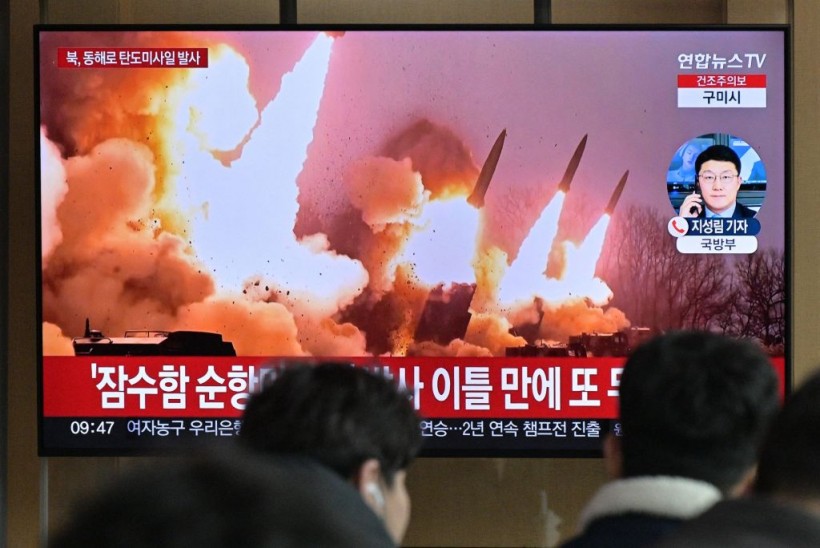North Korea announced on Wednesday that it had successfully tested new solid-fuel engines designed for intermediate-range ballistic missiles, raising concerns about the country's expanding nuclear capabilities.
This development comes as the reclusive nation seeks to bolster its arsenal with more potent and harder-to-detect weapons capable of targeting US military bases in Guam and Japan, as per ABC News.
North Korea's Missile Tests

People stand near a television showing a news broadcast with file footage of a North Korean missile test, at a railway station in Seoul on March 14, 2023. - North Korea fired two short-range ballistic missiles on March 14, 2023, Seoul said, Pyongyang's second launch in three days and the first since South Korea and the United States began their largest joint military drills in five years.
The Korean Central News Agency (KCNA) reported that North Korea's military scientists conducted tests on both first-stage and second-stage missile engines over the weekend. However, the report remained vague about when the new missile system might be completed, shrouding the situation in even more uncertainty.
This announcement follows a series of recent tests by North Korea, showcasing its relentless pursuit of advanced weaponry. Some analysts speculate that these efforts could be fueled by alleged arms cooperation with Russia, as both nations appear to align themselves against the backdrop of escalating tensions with the United States.
Adding to the intrigue, Russia's natural resources minister, Alexander Kozlov, arrived in North Korea for undisclosed discussions regarding trade and technology exchanges. These interactions stem from a rare summit in September between North Korean leader Kim Jong Un and Russian President Vladimir Putin, which included Kim's visit to Russian rocket and military facilities.
This has raised suspicions of a potential arms partnership, with North Korea providing munitions for Russia's conflict in Ukraine in exchange for advanced military technology to enhance Kim's nuclear program.
North Korea's current intermediate-range missiles, such as the Hwasong-12, rely on liquid-fuel engines that require fueling before launch and cannot remain driven for extended periods. In contrast, solid propellant missiles are quicker to prepare for launch, more accessible to transport, and simpler to conceal, making them less vulnerable to detection and preemptive strikes.
KCNA asserted that these recent engine tests were essential for enhancing North Korea's strategic offensive capabilities, citing a grave and unstable security environment and the anticipation of increased military collusion among adversaries.
The successful engine tests suggest North Korea may conduct a flight test of the new missile shortly. If realized, this missile could potentially pose a threat to Guam, a significant US military hub, and American bases in Japan. This may further motivate Japan to bolster its military capabilities and strengthen its security cooperation with South Korea and the United States, according to Reuters.
Read Also: Los Angeles I-10 Freeway Fire Was 'Set Intentionally,' California Gov. Gavin Newsom Claims
Japan's Concerns Amid Korean Peninsula Tensions
Japan's Chief Cabinet Secretary Hirokazu Matsuno acknowledged North Korea's efforts to improve its "sneak attack capability" and expressed concerns about potential provocations, including missile launches and nuclear tests. He emphasized Japan's commitment to gathering information, analyzing, and surveillance to counter such threats.
Tensions on the Korean Peninsula have reached their highest point in years, with Kim Jong Un's aggressive weapons demonstrations and threats, including simulated nuclear attacks on South Korea.
South Korea has increased joint military exercises with the United States to counter these provocations. It seeks stronger assurances from Washington regarding the use of US nuclear weapons in the event of a North Korean nuclear attack.
In a show of strength, the United States recently deployed nuclear-capable aircraft and fighter jets to conduct joint exercises with South Korean warplanes. These exercises aimed to showcase the allies' capacity to promptly and decisively react to provocations from North Korea.
During their yearly security discussions, US Defense Secretary Lloyd Austin and South Korean Defense Minister Shin Won-sik signed a revised bilateral security agreement. The agreement reaffirmed the United States' dedication to safeguarding South Korea, including the potential deployment of nuclear forces if required.
The recent engine tests have provided North Korea with confidence in accelerating the development of its new intermediate-range ballistic missile system. As the world watches with trepidation, the intricacies of international geopolitics, arms partnerships, and the ever-present specter of a nuclear-armed North Korea continue to perplex and confound observers.
The uncertainty surrounding the Korean Peninsula remains a perplexing and volatile issue that demands the international community's continued attention and diplomatic efforts, Al Jazeera reported.
Related Article: 3 Indian Cities Listed as Part of 10 Most Polluted Areas Worldwide After Celebrations of Diwali Festival









